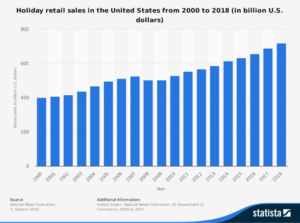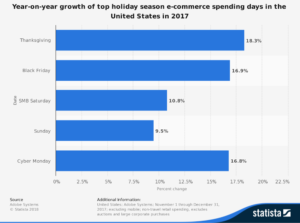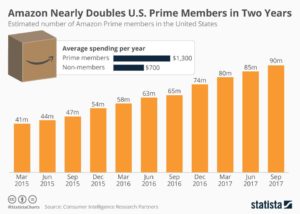Black Friday and its shopping craze have been the hallmark beginning of the United States’ holiday season for decades, with the term first becoming popular in print in the 1960s. In years past, the holiday (if one can call it that) has been characterized by eager deal-seekers crowding outside of stores, waiting for midnight to strike so they can grab hot, discounted items before they’re sold out. It has become an iconic sight to see the most intense shoppers actually fight over the last product on the shelf, with many recorded fights turning into viral videos in the process. Black Friday is, after all, the busiest shopping day of the year.
Black Friday isn’t just a family shopping tradition — it’s an economic necessity for retail, too. In the U.S. economy at large, consumer spending accounts for about two-thirds of U.S. economic activity, and holiday spending makes up a decent chunk of that. For example, in 2013, the U.S. retail industry generated over $3 billion in sales during the holiday season, accounting for 19.2 percent of the industry’s total sales that year. Additionally, 768 thousand employees were hired to aid with the increase in consumer shopping, according to Statista. After a dip in spending following the 2008 recession, holiday retail sales have continually been on the incline.

Holiday retail sales continue to soar. Source: Statista
Holiday spending in 2018 will be no exception. With the Los Angeles Times reporting high consumer confidence with low unemployment, rising incomes and a greater sense of job security, shoppers are spending enthusiastically. This holiday season, retail sales are expected to total $1 trillion (a 5.8 percent increase from 2017) according to research by eMarketer, and online sales may reach $123.73 billion (a 16.6 percent increase from 2017).
Black Friday 2018 saw record online sales, raking in $6.22 billion, which is up 23.6 percent from a year ago. With that, $2 billion of those sales stemmed from smartphones, according to CNBC.

Increases in e-commerce spending across Thanksgiving weekend. Source: Statista
As Black Friday trends show, online shopping, clearly, is the future of retail. The e-commerce giant Amazon has been at the forefront of consumers’ shift from physical shopping to online shopping. Outside of holiday expenses, Amazon has proven to be strong competition with large brick-and-mortar stores that were once thought to be invincible. Take Macy’s and its iconic red star for instance. In June 2018, the company’s stock price was down 45 percent from its all-time high in July 2015. Additionally, Amazon is estimated to pass the behemoth Walmart and become the top player in the U.S. apparel industry, according to Investopedia.

The increasing popularity of Amazon demonstrates that the e-commerce giant is the prime (pun partially intended) destination for online sales. Source: Investopedia
I don’t necessarily think brick-and-mortar stores are going anywhere because they are still central to the American shopping experience. After all, It wouldn’t be the holidays without someone anxiously running to Best Buy to purchase some discounted 60 in television. The prominence of e-commerce, however, will only continue to offer more competition to physical retailers, which will be an interesting trend to watch as the digital age continues to envelop our lives.